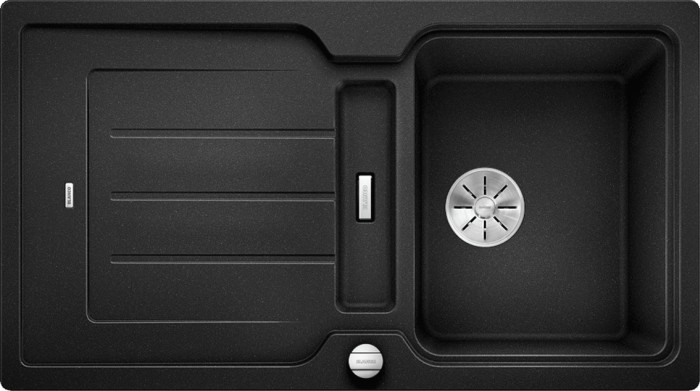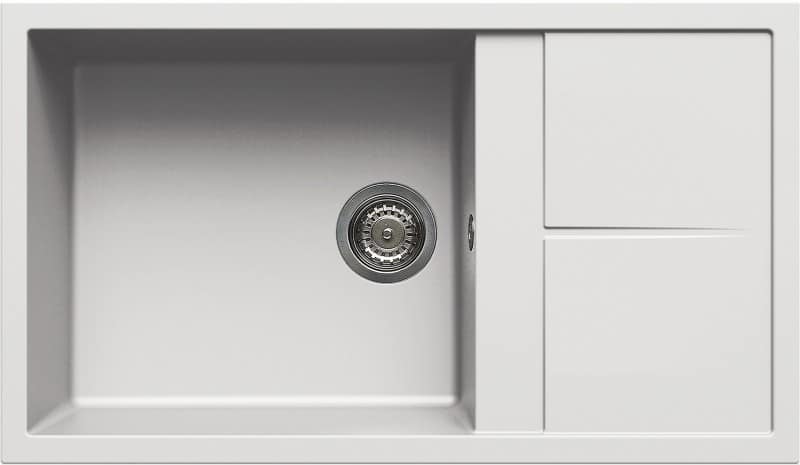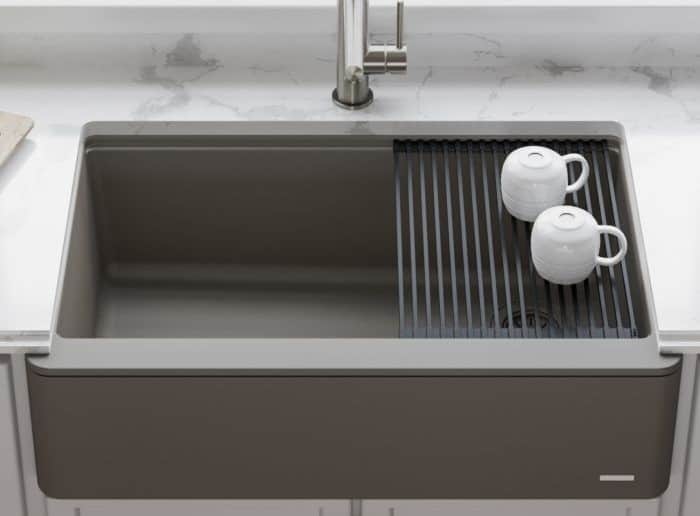One of the important decisions you’ll have to make when designing your new or renovated kitchen comes down to the type of sink you’re going to have installed in your countertop.

No, your sink probably isn’t going to become the main hub of activity in your kitchen the way that the kitchen table, island, or refrigerator will – but it is going to see a lot of use (more than maybe anything else in your kitchen) and should be well designed to stand up to that wear and tear while still adding a punch of visual style to the mix, too.
We’ve come a long way from plastic or stainless steel only kitchen sinks. Today you can pick up a gorgeous granite composite sink that not only looks amazing but also has the kind of durability that you are looking for – the kind of durability you won’t get out of most other sink options money can buy today.
Granite composite (compared to just standard granite) offers a lot of benefits, not the least of which is its ability to resist high heat and cold temperature swings, it’s natural resistance to scratching, staining, and chipping, and its ability to be made in a wide variety of different colors – including matte finishes – that you would have had a tough time getting out of traditional granite alone.
At the same time, there are definitely some drawbacks to moving forward with granite composite sinks as well.
We dig a little deeper into the shortcomings of this material below so that you know exactly what you are getting into when you make the move to have one of these beautiful sinks dropped into your kitchen space.
Let’s get right into it!
Advantages of Granite Composite Sinks
Granite composite sinks have exploded in popularity in just the last few years and it isn’t hard to understand why.
Luxurious without the skyhigh cost and regular maintenance traditional granite brings to the table, this material is super strong and durable but not so “hard” that you have to baby the glasses or dishes that you are tossing in the sink to be rinsed or cleaned.
Lower Price Than Full-Granite Sinks
Another reason that people really like granite composite sinks is that you get 99% of the traditional granite look without the skyhigh granite price tag – and that is (usually) reason enough for folks to go in this direction.
Traditional granite sinks can cost an arm and a leg, and once you start to get into some of the more “exotic” granite patterns they can begin to cost even more than that.
Nobody wants to have to decide between buying a new car and a kitchen sink – and while granite sinks aren’t quite that expensive, it can feel like that sometimes when you get a look at traditional granite price tags.
Granite composite, however, is always a lot less expensive than what you would have spent going the traditional route. It’s not at all uncommon to find these sinks at prices between 25% and 50% lower than what traditional granite would have cost homeowners, making them something you want to consider for sure.
Durable
The durability of granite composite is absolutely off the charts.
You get a lot of the hardness, strength, and rigidity that a traditional granite sink would have brought to the table combined with the forgiveness, slight malleability, and “flexibility” of composite materials all at the same time.
This means you get a gorgeous, stiff sink that’s going to look strong and durable without having to worry about your dishes breaking immediately on contact when you toss them into the sink to be rinsed off or to be cleaned.
Variety of Sizes, Styles, Shapes
When you are dealing with natural granite materials you have to work around whatever Mother Nature decided to make all those years ago – something you aren’t completely beholden to when you choose to move forward with granite composite.
There are a lot more styles, a lot more patterns, a lot more shapes, and many more size options available when you choose to go in this direction thanks to the hybridization of granite and composite materials. You open up a world of kitchen design creativity when you decide to go in this direction.
Nonporous, Hygienic, and Resistant to Heat
Natural granite is pretty porous and has to be sealed (and then resealed on a regular basis) to work well as a sink, maintenance that most homeowners just aren’t interested in tackling every six months or even every year.
With granite composite materials, though, you get a highly nonporous and almost hydrophobic material that sheds water just like a duck’s back would.
Because of that you are talking about a sink that is a whole lot more hygienic, as there aren’t any nooks or crannies that bacteria can hide inside the way it might have been able to with a granite sink.
Cleaning is Easy (No Chemicals Needed)
Keeping your granite composite sink looking just as good as brand-new is pretty simple and straightforward.
A little bit of regular cleanup every now and again (maybe every month or so) goes a long way towards keeping the finish looking fantastic.
If you are cleaning things that are particularly acidic or have a high potential to stain you might want to scrub a little more aggressively that night – pasta night or any night that a bit of wine and up going down the drain – but other than that you don’t have to babysit granite composite the way you do with traditional granite sinks.
Disadvantages of Granite Composite Sinks
While kitchen designers and homeowners around the world have flooded towards granite composite sinks in just the last few years (and for a lot of good reasons, as highlighted above) this isn’t to suggest that these sinks are without their flaws.
Cheaper Sink Options Out There
For starters, even though granite composite options are significantly cheaper than traditional granite options they aren’t exactly the “budget choice” for homeowners today.
Stainless steel sinks are still the absolute rock-bottom of the market as far as pricing is concerned, all while providing a lot of the same benefits (maybe a couple of extras) that granite and granite composite sinks cannot offer just yet.
If you’re making your new sink decision based off of price alone you’ll want to look somewhere other than granite composite.
Decent Risk of Chipping and Cracking
While the risk of chipping and cracking goes down significantly when you combine granite with composite materials that doesn’t mean that the risk is eliminated entirely.
You are, after all, still dealing with 95% natural granite materials that have the potential to become compromised – even if that material is protected with 5% resin or some other composite that holds everything together.
You can beat up a granite composite sink a little more than traditional granite thanks to the impregnation of that resin material, but you can’t necessarily drop heavy pots and pans into the sink without expecting something bad to happen all the same.
Pretty Big, Bulky, and Heavy
Stainless steel sinks are beloved because of how easy they are to install, in large part because they are lightweight enough to be handled comfortably with a single hand.
That’s not going to happen with granite composite.
This material is still pretty big, still pretty bulky, and definitely on the heavier side of things. You’ll want a bit of help installing this new sink in your kitchen, but you’ll also want to consider reinforcing the area around your sink drop in (and maybe even beneath your sink) just to make sure that your granite composite choice isn’t stressing out your countertops or your cabinets.
Require Special Upkeep
Special upkeep is going to be required every year or so (or if anything particularly acidic or with a high stain probability makes it into your sink, as we highlighted above) – even if it’s less special upkeep than traditional granite would demand.
Special nonchemical cleaning agents have been cooked up by a couple of companies to help you make quick work of your granite composite, and that’s a great way to go if you’re looking to keep everything nice and clean (and hygienic) without destroying the finish or potentially compromising the resin in your sink to begin with.
You won’t, however, have to go through the resealing process that you might have had to go through with traditional granite options.
That’s a big bonus even if a little bit of special maintenance is necessary, as there aren’t too terribly many people that get jazzed up about the idea of having to reseal their granite sink every 12 months just to keep it looking nice.
Higher Potential for Staining with Lighter Colors
Lighter colors in the granite composite world have a much higher chance of staining than darker colors, for obvious reasons.
What might interest you even more, though, is that lighter colored granite composites havoc and even higher chance of staining than lighter colored traditional granite sinks.
A lot of this has to do with the kind of resin used in light-colored composite sinks, a resin that can absorb a lot of the acidic or staining material into itself and then “hold it” on a nearly permanent basis – with the only way of getting rid of it being to destroy that chunk of resin and then refinished the entire sink (or replace the whole sink itself).
If you’re a house that has a lot of frequent pasta nights or a house that drinks a lot of wine (some of which that ends up in the sink) you’ll want to make sure that you stay on top of cleaning things quickly and efficiently or you run the risk of staining your lighter granite composites.
A lot of this can be avoided by going with a darker color. But if you want that bright, brilliant white or another lighter tone because of the visual impact it a have in your kitchen more cleaning will be necessary as a trade-off.
Popular Granite Composite Sink Brands
Plenty of great companies are doing amazing work in the granite composite sink world these days, but three options stand head and shoulders above the rest of the pack.
If you’re going to be spending your money on granite composite sinks you want to be sure that that money is well spent, and you really can’t go wrong with any of the options available from the three companies that we highlight right here.
Blanco

The folks at Blanco have created their own proprietary granite composite material that they call Silgranit, a granite composite composed of 80% granite dust and 20% resin and composite materials.
With a wide variety of styles and colors (as well as shapes and sizes) you’ll find these granite sinks to be durable, easier to maintain and absolutely gorgeous – worthy additions to any new kitchen design.
Granitek

Based out Italy, this company was established back in 1997 and is a real pioneer in the world of granite composite.
Combining natural stone with acrylic resin to produce a hybrid material that is gorgeous to look at and highly durable, these granite sinks offer the best of all worlds when it comes to granite and composites.
Kraus

Known all over the world for the high-end kitchen sink products that they have produced for decades, Kraus has a reputation for bringing some of the most impressive engineering and design into the world of kitchen sink products – and that extends to their granite composite sink options, too.
The designs that Kraus comes up with our very minimalistic, very modern and stylish, and similar to what you might have expected the folks at Apple (or another high-tech company) to design if they got into the kitchen sink world.
Durable, strong, and well-made across the board these are top-tier composite sinks to consider for sure.
Are Granite Composite Sinks Better Than Stainless Steel?
Granite composite and stainless steel are both popular types of kitchen sinks, and each one has its own advantages and disadvantages.
The granite composite sink is durable and long lasting, and it is resistant to chipping and scratching. It can also withstand heat up to 530 degrees Fahrenheit as well as pressure. They are easy to clean without using toxic chemicals, and they are attractive and look similar to natural stone. They are very attractive in the kitchen.
Stainless steel is also durable and resists rust, chips, and cracks. It is versatile and comes in different sizes. It can have a shiny or a matte finish, and it can handle the weight of heavy pots and pans. It is also easy to clean, and it is less expensive than granite composite sinks. There are many different options, so you can find them with unreliable quality if it is not a trusted brand.
The two styles are different, so you need to decide which fits in better with your budget and your decor. Stainless Steel sinks are cheaper but Granite Composite looks more luxurious and lasts longer.
Can You Use Bleach on Granite Composite Sinks?
Granite composite sinks are low-maintenance, and they are easy to clean. You can usually clean them with warm water, soap, and a dish towel.
The granite in this sink is sensitive to chemicals such as bleach, so you should not use bleach on this type of sink.
You can use a natural solution such as vinegar and baking soda if you have a tough spot to clean. You should also use soft fabrics, a bristle brush, or a rag when you scrub the sink as wire cleaning brushes can damage the sink. You can also use general household cleaners but be sure to avoid harsh chemicals.
Do Granite Composite Sinks Crack Easily?
Granite composite sinks do not crack easily, but you do need to exercise caution because they can crack or chip if you are careless.
If you place boiling-hot water or hot pans in the sink, you might end up with a crack. However, this is pretty uncommon.
These sinks are heat-resistant up to 530 degrees Fahrenheit, but you should still make sure that you let pots cool before placing them inside the sink.
You also need to exercise caution when you put heavy pots or pans in the sink because there is a risk of chipping.
What Is the Difference Between Granite and Composite Sinks?
Granite and granite composite sinks are two different types of sinks. Granite sinks are made of 100% natural stone, while composite sinks are artificially formulated using 95% natural stone and 5% resin material.
Each piece still has its own blend and pattern, and granite composite is harder and heavier than natural granite.
Both resist heat and are resistant to scratching and stains when cleaned properly, but granite composite is less expensive.
Natural granite also requires sealing because it is porous, while granite composite is low-maintenance.
Are Blanco Sinks Made in the USA?
The Blanco patented granite composite sink (SILGRANIT) is made in North America at their manufacturing facility in Toronto, Ontario, Canada.
Their national headquarters are located in Lumberton, New Jersey, and they have been making sinks and faucets for more than 30 years. The headquarters handles the marketing, finance, and shipping logistics for their sinks.
Are Composite Sinks Scratch-Resistant?
Composite sinks are scratch-resistant. They are made using a mix of natural granite stone dust and acrylic resins, and it is hard and durable.
It has a hard, dense surface that will resist chipping, scratches, and cracking. That said, it can get scratched over time. If it does, you can restore it by cleaning and sealing it or by filling in the crack with epoxy. There are restorer kits that make the process pretty uncomplicated.
Related Posts
- 11 Ways to Get Rid of Cooking Smells in a Small Apartment or House
- Comparison of Corian Countertops vs Laminate for Kitchens
- All About Fragranite Kitchen Sinks With Pros & Cons
- Comparison of Granite Composite Sink vs Stainless Steel
- How Much Does it Cost to Paint Kitchen Cabinets?
- What Color Granite Goes With Maple Wood Kitchen Cabinets?
Good day I am so glad I found your webpage, I really
found you by error, while I was looking on Digg for something else, Regardless I am here now and would just like to say kudos
for a marvelous post and a all round entertaining blog (I also love the
theme/design), I don’t have time to read it all at the moment but I have bookmarked it and
also included your RSS feeds, so when I have time I will be back to read
a lot more, Please do keep up the awesome work.
Will these sinks hold a 20 pound disposal ?
I have ordered Blanco sinks for our upcoming kitchen remodel, but am having second thoughts because of all the complaints I read about these sinks cracking after the install. One person said the sink cracked after she drained the water out of the pot in which she was cooking pasta. If I sink can’t handle boiled water without cracking, that seems ridiculous. How are you supposed to drain your pasta? Wait until it and the water gets cold? Even if it’s a rare occurrence, why should this ever be happening if the sink is supposed to be able to withstand 530 degrees?
My black Coral 050 Granite Graphite Moulded Graphite sink is looking really bad lately. When the sink is slightly wet with water or oil it looks great, but if just clean and dried the bottom is a much lighter uneven color.
I watched some YouTube videos about removing lime, and soap scum to restore the black color in these sinks, but most of the products they use don’t seem to restore the surface color well.
One product in particular 511 Sealer might work. I thought I would ask you first?
Sorry I don’t know the particular product.
Placed hot pot in sink and it burned into the sink in tmo spots, leaving divots in the surface of the sink. Any way to fill and/or seal these to even somewhat bring back look of the sink? Sink is granite composite.
Mike, I suggest you speak with the company from where you purchased the sink. They should have encountered similar situations as yours and will know exactly how to fix it.